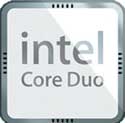
How much faster are the new iMacs?
Let’s face it, with the announcement of the new iMacs we all pondered just one question: How much faster are they in real-life conditions?
A respected German computer magazine (c’t Magazin für Computer Technik, ISSN# 0724-8679) took a look in their most recent issue (4/2006, pages 82-84) – and their findings don’t quite support Mr. Jobs’ announcement of a machine that runs at 2-3 times the speed of it’s predecessors. Intel native applications will run faster most of the time, but not all of the time. Applications running under Rosetta, not surprising at all, are much slower all of the time.
Johannes Schuster of C’T had quite a task at hand, as his usual benchmarking tool isn’t Intel native, so how to compare? He decided on a number of processor intensive tasks and measure the time it took to complete. His findings were explained in detail in the article and I’ll try to summarize his findings, without getting in trouble for copyright infringement.
Intel Native Programs
One would assume that those programs already ported to the new platform would run much faster all of the time. This is what Mr. Jobs suggested when he circulated the benchmark figures in his keynote speech in San Francisco. The startling surprise is, that they are faster, sometimes, but rarely by the 2-3x factor.
Encoding MP3 tracks in iTunes; using Quartz Extreme with transparent windows; and playing a song in GarageBand 3 with a large number of simultaneous midi-tracks, all are faster (or can play more tracks) by about 16-30%, when comparing a new iMac Core Duo 2.0GHz 20″ to its iMac G5 2.1GHz 20″ predecessor. So faster they are, but not all that much.
Transcoding a DV-Movie to MPEG-4 in QuickTime surprisingly took nearly twice as long on the new iMac Core Duo. Yes, I wrote “twice as long”, a task that any of us would have thought should run much faster, ran much slower.
So where is the 2-3x speed increase?
Only when using the newly ported, and almost finished, Cinebench Intel benchmarking suite, the new iMac scored a significant speed increase of 205%, which finally confirms Mr. Jobs’ claim. However, only when looking at the rendering results, that means a multi-thread task, ideally suited for a dual-core processor.
Under Rosetta
Well, it won’t surprise you, but under Rosetta the new Macs are slower, between 44% and 80% according to the findings of Mr. Schuster. What surprised me most is that various tasks in PhotoShop were slower only by the lower end of the above scale and sorting records in FileMaker hit the upper end of the scale.
Conclusion
In the end these are all just figures and the reason we are so fascinated by them is because Steve Jobs started the game. When he announced the new core duo machines he didn’t chose to compare them to the older G4, but to the latest iMac G5 and presented figures that suggested a machine that would be incredibly fast. Unfortunately incredible is the word that sticks, after looking at the findings of Mr. Schuster of C’T Magazin für Computer Technik in Germany.
But is this really such bad news? No, it isn’t. If you bought yourself a fast iMac G5 last Christmas the good news is, you have a very competitive machine and will enjoy a superb experience for quite some time to come. So time to pocket that buyer’s remorse. In fact, these figures are a reason to cheer – your machine is giving you better performance in your day-to-day business tasks, like using Word or FileMaker.
If you were thinking of upgrading from a much older machine to a new Intel powered Mac, should these figures stop you? No – because the new machine is going to be much faster than your G3 or G4. If you can wait a little longer, you might just want to do so to see more of your core applications ported and have an even better experience. But go right ahead and buy – you’ll get a great machine.
So did Steve lie? I don’t think he did, the Cinebench comparison shows that with the right application and task at hand the new iMac Core Duo is going to be FAST. So all we need right now is the right native applications and the right tasks to see the speed increase Steve offered us. The only scary bit about it – as he launched the new Macs so much sooner than initially announced, we might have to wait for those new applications a little while and by that time there might be a much faster Core Duo available.

Leave a Reply
You must be logged in to post a comment.